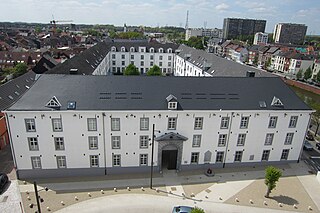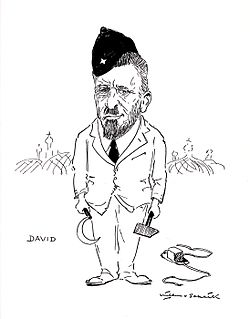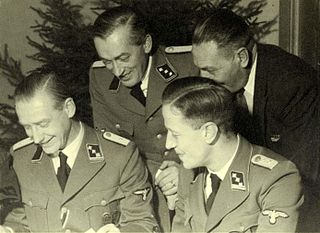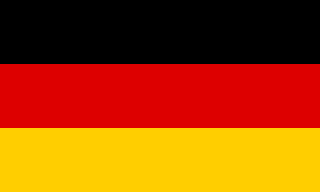
Petrus Jozef Sietse "Piet" de Jong was a Dutch politician and naval officer who was Prime Minister of the Netherlands from 5 April 1967 to 6 July 1971. He was a member of the Catholic People's Party (KVP), which later merged into the Christian Democratic Appeal (CDA).

Wilhelmina was Queen of the Netherlands from 1890 until her abdication in 1948.

Vught is a municipality and a town in the southern Netherlands, and lies just south of the industrial and administrative centre of 's-Hertogenbosch. Many commuters live in the municipality, and the town of Vught was once named "Best place to live" by the Dutch magazine Elsevier.

Sobibor was a Nazi German extermination camp built and operated by the SS during World War II near the railway station of Sobibór near Włodawa within the semi-colonial territory of General Government of the occupied Second Polish Republic.

Despite being neutral, the Netherlands in World War II was invaded by Nazi Germany on 10 May 1940, under orders of Adolf Hitler. On 15 May 1940, one day after the bombing of Rotterdam, the Dutch forces surrendered. The Dutch government and the royal family saved themselves by going to London. Princess Juliana and her children moved on to Canada for additional safety.

The Drancy internment camp was an assembly and detention camp for confining Jews who were later deported to the extermination camps during the German military administration of Occupied France during World War II. It was located in Drancy, a northeastern suburb of Paris, France. Between 22 June 1942, and 31 July 1944, during its use as an internment camp, 67,400 French, Polish, and German Jews were deported from the camp in 64 rail transports, which included 6,000 children. Only 1,542 remained alive at the camp when Allied forces liberated it on 17 August 1944.

Operation Black Tulip was a plan proposed in 1945, just after the end of World War II, by Dutch minister of Justice Kolfschoten to forcibly deport all Germans from the Netherlands. The operation lasted from 1946 to 1948 and in the end 3,691 Germans were deported.
The history of the Jews in the Netherlands is considered to begin largely in the 16th century, when they began to settle in Amsterdam and other cities. It has continued to the present. Following the occupation of the Netherlands by Nazi Germany in May 1940, the Jewish community was severely persecuted. 70% of its members died in the Holocaust during World War II.

The Dutch resistance to the Nazi occupation of the Netherlands during World War II can be mainly characterized as non-violent, and was organized by the Communist Party, churches, and independent groups. A peak of over 300,000 people were hidden from German authorities in the autumn of 1944, tended to by some 60,000 to 200,000 illegal landlords and caretakers, and tolerated knowingly by some one million people, including a few incidental individuals among German occupiers and military.
The Henneicke Column was a group of Dutch Nazi collaborators working in the investigative division of the Central Bureau for Jewish Emigration, with headquarters in Amsterdam, during the Nazi Germany occupation of the Netherlands in World War II. Between March and October 1943 the group, led by former auto mechanic Wim Henneicke and Willem Briedé, was responsible for tracking down Jews in hiding and arresting them. The group arrested and "delivered" to the Nazi authorities 8,000-9,000 Jews. Most of them were deported to Westerbork concentration camp and later shipped to and murdered in Sobibor and other German extermination camps.

Amersfoort concentration camp was a Nazi concentration camp in Amersfoort, Netherlands. The official name was "Polizeiliches Durchgangslager Amersfoort", P.D.A. or Police Transitcamp Amersfoort. During the years of 1941 to 1945, over 35,000 prisoners were kept here. The camp was situated in the southern part of Amersfoort, on the city limit between Amersfoort and Leusden in central Netherlands.

Herzogenbusch concentration camp was a Nazi concentration camp located in Vught near the city of 's-Hertogenbosch, Netherlands. Herzogenbusch was, with Natzweiler-Struthof in occupied France, the only concentration camp run directly by the SS in western Europe outside Germany. The camp was first used in 1943 and held 31,000 prisoners. 749 prisoners died in the camp, and the others were transferred to other camps shortly before the camp was liberated by the Allied Forces in 1944. After the war the camp was used as a prison for Germans and Dutch collaborators. Today there is a visitors' center with exhibitions and a national monument remembering the camp and its victims. The camp is now a museum.

The Holocaust, also known as the Shoah, was a genocide during World War II in which Nazi Germany, aided by local collaborators, systematically murdered some six million European Jews—around two-thirds of the Jewish population of Europe—between 1941 and 1945. Jews were targeted for extermination as part of a larger event during the Holocaust era, in which Germany and its collaborators persecuted and murdered other groups, including Slavs, the Roma, the "incurably sick", political and religious dissenters such as communists and Jehovah's Witnesses, and gay men. Taking into account all the victims of Nazi persecution, the death toll rises to over 17 million.

The Mechelen transit camp, officially SS-Sammellager Mecheln in German, was a detention and deportation camp established in a former army barracks at Mechelen in German-occupied Belgium. It was managed by the Sicherheitspolizei (SiPo-SD), a branch of the SS-Reichssicherheitshauptamt, in order to collect and deport Jews and Romani mainly out of Belgium towards the labor camp of Heydebreck-Cosel and the concentration camps of Auschwitz-Birkenau in German occupied Poland.

The Lublin Reservation was a concentration camp complex developed by Nazi German Schutzstaffel (SS) in the early stages of World War II, as the so-called "territorial solution to the Jewish Question". The idea for the expulsion and resettlement of the Jews of Europe, into the remote corner of the Generalgouvernement territory bordering the cities of Lublin and Nisko, was devised by Adolf Hitler and formulated by his SS henchmen as the so-called Nisko und Lublin Plan named alternatively after both locations. The plan was developed in September 1939 after the invasion of Poland and implemented between October 1939 and April 1940, in contrast to similar Nazi "Madagascar" and other Jewish relocation plans drawn up before the attack on Poland at the onset of World War II.

Johan Willem van Hulst was a Dutch school director, university professor, author and politician. In 1943, with the help of the Dutch resistance and students of the nearby University of Amsterdam, he was instrumental in saving over 600 Jewish children from the nursery of the Hollandsche Schouwburg who were destined for deportation to Nazi concentration camps. For his humanitarian actions he received the Yad Vashem distinction Righteous Among the Nations from the State of Israel in 1973.

David Joseph Wijnkoop was a Dutch communist leader in the first half of the twentieth century. He was the eldest son of upper rabbi Joseph Wijnkoop and Dientje Milia Nijburg.
Walter Süskind was a German Jew who helped about 600 Jewish children escape the Holocaust. He was a member of the Dutch Jewish council during the Second World War.

Ferdinand Hugo aus der Fünten, widely known as Fünten, was an SS-Hauptsturmführer and head of the Central Office for Jewish Emigration in Amsterdam during the Second World War. He was responsible for the deportation of Jews from the Netherlands to the German concentration camps and was convicted as a war criminal.




















